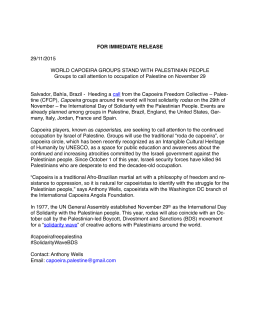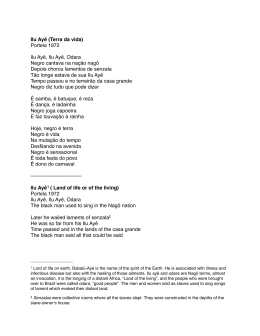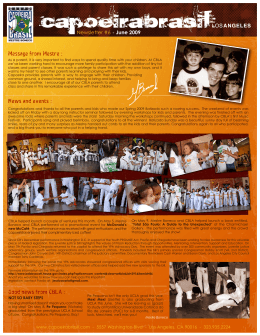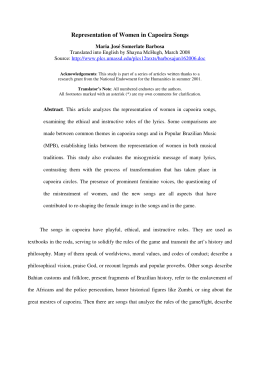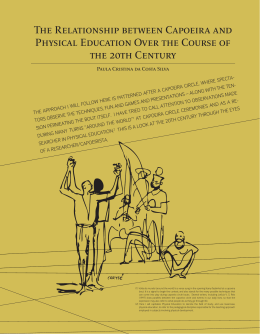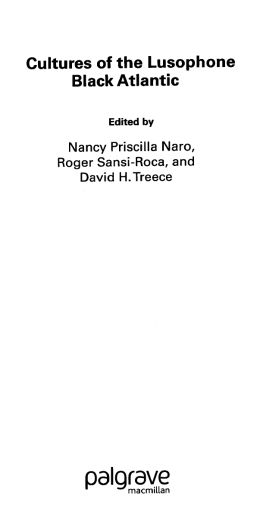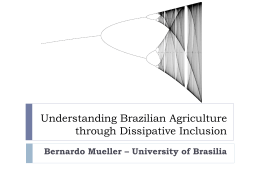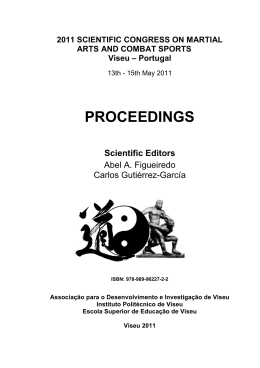Capoeira and Social Inclusion Gladson de Oliveira Silva Vinicius Heine CAPOEIR A WAS B ORN OF VERY C AN OPP ORE OF RESSED C A P PEOPLE OEIRA, S GHOUT ’S STRU IN ITS HIST CE IT O GGLE FO O R IGINATE RY, CAP THE MA R FREED D AMON OEIRA H INSTREA OM. INC G A S SOCIAL M, YET ALWAYS LUSION AND CU L Y W IS AT TH HO NEV BEEN A EXCLUD LTURAL E S E E S R CEAS D GROU OCIATE VALUES E D SION. M P D S W T . . H IT T F E H H OR THIS IR STRU ROUPEOPLE EN AND GGLE TO REASON EXCLUD WOMEN BROUGH , A E C F D FROM APOEIR OF ALL FIRM TH T TOGE A HAS E EIR IDEN ORIGINS THER BY N , T SICAL B O A IT RMOUS GES, FA Y, RIGHT THE CA OW, THE ITHS, IN POTENT S POEIRA Y A C IA R C O L E IR M AND BR F A C E O L L S R L E AND CU CITIZEN CEREMO INCLUING ABO S OF TH LTURAL NY, OR UT SOC E WORL R L E O IAL JUST VELS A DA. TO D STRIV RE ICE. THE BEA ING TO T OF THE IMPROV MUE THEIR QUALIT Y OF LIF E Ministry of External Relations Texts from Brazil A great mestre does not merely educate for the capoeira circle, but rather, for life in its many dimensions. Capoeira plays a crucial role in fostering inclusion, equality and citizenship. Social distinctions and contradictions are everywhere: in living conditions, employment and educational opportunities, and in access to such basic services as housing, health, safety, transportation, sports, leisure and culture. Throughout all of history, these distinctions and contradictions have reiterated that inequality. Itself a product of popular culture, capoeira can and should contribute to turn this situation around and bring people closer together - to be appreciated for what they are in essence, rather than for their material advantages. It also helps build democratic spaces, within which everyone has equal rights and opportunities. These include opportunities to understand the relations between past, present and future, and above all, to foster political awakening, the responsibilities of citizenship, and fundamental human rights. Capoeira and Social Inclusion CEPEUSP Capoeira Clinic: Integration among Groups THE ROLE OF THE MESTRE. The prime movers in capoeira are teachers and masters, or mestres. They are the ones who foster and teach the basics to the younger generations. It is they who exemplify the principles, the standards, the values and the philosophy to guide their actions and influence the learning and behavior of their students. Students largely reflect the example and role model provided by their mestre, hence the responsibility of these social actors, who labor directly for the complete education of their students. The pattern for teaching in capoeira is distinct from the traditional pattern of education in schools. This is because the relationship between master and student goes beyond the classroom and extends into many aspects of the student’s own life. A great mestre does not merely educate for the capoeira circle, but rather, for life in its many dimensions. One has to know and care for each student as deeply as possible, 116 Capoeira Capoeira and Social Inclusion and get to know their family, school and community situations. The ability to listen is crucial, as is the ability to share, trade and work together with the students to motivate and give them support. This emotional and intellectual support must, of course, be tendered with the realization that it is not always possible to solve all of the student’s problems. Nor is that even the proper approach. The idea is to offer guidance that will help them to find the best path. To be a mestre is, quite often, to be a father, a friend, or a brother. ment organizations on community projects. Capoeira has played a special role in this context, contributing significantly toward social inclusion. Open-Door Project: Capoeira and Citizenship Projete Liberdade Capoeira Event: Fraternization INCLUSIVE PHILOSOPHY. Social inclusion is a working philosophy. To have it, one must have a commitment to minority causes, to the less fortunate, and to those who feel excluded. Social inclusion should therefore be understood as a process. It is a collective effort aimed at overcoming discrimination, prejudice, intolerance, inequality and stereotyping. We all carry within ourselves some sort of difficulty, a limitation that crops up whenever we meet someone else. In dealing with this one must be able to see the personal and collective viewpoints of others, and find balanced responses that foster unity, cooperation and camaraderie. Every situation in our daily lives offers us opportunities to work toward inclusion. Within the family, at school, in our neighborhoods and at work, we must at all times keep step with the rhythm of social inclusion. PEDAGOGICS OF INCLUSION. Capoeira should be inclusive, careful in its methods and in its pedagogical foundations. It ought to daily foster reflection and value-affirming behavior, be based on affection and establishing healthy and constructive relationships such as will help instill in its practitioners a sense of identity. Throughout all of Brazil there has been a proliferation of work done by nongovern- To firm up capoeira as a space for inclusion, one should begin by establishing knowledge, dialogue and interchange. Communication, interaction and student participation in work involving capoeira ought to be fostered as a living part of your community. Understanding based on its historical, social and cultural foundations is also essential. From its earliest beginnings, capoeira has to this day built its identity on social resistance and the struggle against inequality and injustice. The students must be respected along with all of the emotional baggage they carry. To be mindful of the particulars of each student is to have two-way conversations and learn his identity, life story and worldview. Acceptance, tolerance and respect for differences are essential pillars for establishing a peaceful culture on our planet. There is a need to foster integration, and provide incentives for developing potential and capabilities. In order to be a capoeirista one must want to learn, assimilate rules and the dynamics of the sport, and believe in one’s own self. Capoeira accepts everyone... each with his own contribution, personal touch, rhythm in motion and presence. Cooperation is, as a matter of principle, more important than competition in capoeira. To cooperate is to share and lend support. People can work, build and benefit together. Above all, one must “play with,” and not “play against,” in order that capoeira may perform in the sense of including people whose conditions in life are not the same. 117 Ministry of External Relations Texts from Brazil Gradually over time, capoeira has been working toward the inclusion of people who, until just recently, kept aloof and apart from the sport. One of the primary purposes of this type of work is to foster the development of truly civic-minded community leaders, able to transform their immediate surroundings and the country as a whole – citizens able to make decisions that bring about social justice and promote the welfare of the society in which they live. “Capoeira is for Men, Women and Children”1 Capoeira and Social Inclusion CEPEUSP Event: Interaction with Parents Gradually over time, capoeira has been working toward the inclusion of people who, until just recently, kept aloof and apart from the sport. It was no common thing to see women practicing capoeira. Indeed, they were few and far between. The hardy few who ventured into the capoeira circle soon found themselves with reputations. The ingrained prejudice was that capoeira was a guy thing, “how can any woman even think of hanging out in such an environment.” Attitudes have changed a lot in recent years and, in some groups, women are the majority in classes and at roda practice. There are even women’s capoeira meets, at which discussion runs to such topics as affirming and valuing women in and through capoeira. There is no difference between a women’s capoeira circle and a men’s circle. There are equal opportunities for men and women, and they practice, sing and play as equals, with integration and respect. CAPOEIRA FOR YOUNG AND OLD ALIKE. Two-year old children have begun capoeira practice at schools in Brazil and abroad. The full potential of capoeira as an instrument (1) A verse from a well-known capoeira song. 118 Capoeira Capoeira and Social Inclusion for developing whole human beings has been recognized at many educational centers. More recently, important work has been done with the elderly, which has shown that the sport is a great help in improving their quality of life. Each one practices to the extent of his or her ability and within their limits – limits that are often much farther than one would imagine. Even people who doubt that they have the ability are surprised at the possibilities capoeira offers in terms of movement and opportunities for socializing. Aside from the sport itself, with its attack, defense and acrobatic moves, the attraction capoeira has for the elderly is its entertaining, artistic and sociable side. Happy, spontaneous and pleasant movement is essential. To belong to a group, to be among friends, to relate to and interact with others... these are all basic requirements for healthy, happy human beings of all ages, especially in their senior years. SPECIAL CAPOEIRA. No discourse on the subject of inclusion would be complete if it left out those who have special needs. Foremost among these special needs is the ability to believe in life and to overcome limitations, to make that turnaround, develop one’s potential and achieve one’s goals. To these challenged individuals capoeira has been a wonderful tool for biological, psychological and social development. People with special needs are able to participate in capoeira practice, whether through its movements, by singing or playing an instrument. A host of new methods have been developed for teaching capoeira to this population. Capoeira’s capacity for inclusion is increasing constantly. Workgroups have been organized exclusively for people with special needs, and there are mixed groups sharing a common space, with remarkable results. People are special for many different reasons, but mainly for having an unusual level of sensitivity. What would at first seem a limitation, in practice turns out to be a challenge which, once overcome, brings them happiness and a sense of personal achievement. PROFESSIONAL DEVELOPMENT. Another element that is essential within this process of inclusion through capoeira is the need to provide its representatives (mestres, assistant mestres, instructors and monitors) training and qualifications, and offer knowledge and methods that will enable these professionals to work more effectively. There are some very creative, inventive and willful people among the capoeiristas. These are highly capable go-getters who, despite their lack of material resources, do extraordinary work that truly merits praise, recognition and, above all, greater incentives. The Brazilian government clearly recognizes capoeira’s potential for fostering citizenship, and has been backing programs which include this sport. The sheer size of the field of capoeira, together with its potential, indicate that these efforts have a long way to go. A more consistent approach is needed, one that will generate knowledge and a continuous, systematic approach to the work at hand – along with providing its teachers with training and qualifications. What we see out there are isolated initiatives, limited to a few groups. There is not much coordination and exchange of information. Much of what is being accomplished flows from the creativity and individual effort of a few capoeira mestres and teachers. Priority should be given to coordinated action involving the government, universities and the capoeira community. CAPOEIRA EN FAMILLE . The family’s presence and participation is very important to this process of education and inclusion through capoeira. Parents, brothers, uncles, grandparents, cousins and offspring are the references most familiar to the student. It is within the family that the student gains those earliest of life’s experiences. What the individual goes through in the family home will greatly influence that person’s character, feelings, behavior and attitude. CEPEUSP Event: the entertainment value of Capoeira We are aware, however, that the environment for many families nowadays is dysfunctional and conflict-ridden. Conflicts between parents have an enormous effect on children, and can result in bad behavior and poor social skills. Aggressiveness, trouble concentrating, attention disorder, rebelliousness, the inability to get along in groups and to accept rules, low self-esteem and hostility toward older people may sometimes be observed in children from dysfunctional families or broken homes. 119 Ministry of External Relations Texts from Brazil The struggles of capoeira have inspired millions of Brazilians in their own personal struggles, to do for themselves and for their communities. The main goal of the project is transformation through participation in cultural activities. Out of it come honest and sensitive citizens, eager to pitch in. Capoeira and Social Inclusion Difficulty in the home environment, however, need not burden children with problems. A child’s self-esteem and sense of worth reawaken after finding and getting to know another environment, in which there is love, respect, dialogue, discipline and understanding. Their behavior and social skills improve, and they begin behaving in an ethical and balanced manner in both their family and community relations. This is precisely where capoeira can play a decisive role in the lives of younger people, and contribute toward their social inclusion by providing a space for rebuilding their lives. To accomplish this, however, there must be trust and dialogue between mestre and students, and among the students themselves. GLOBAL INCLUSION. Capoeira has become international in scope. Everywhere in the world, in hundreds of countries, one hears the twang of the berimbau. Russia, Japan, Germany, South Africa, Peru and the United States have long since stepped into the capoeira ring. In Brazil, capoeira has shown its ample capacity for inclusion. Exchanges and interchanges among capoeiristas of different nationalities are commonplace. Every year, people from all over travel to other countries to benefit from each others’ experience with capoeira. Brazil plays host to large numbers of practitioners seeking to gain new knowledge and expand their wisdom. THE “OPEN DOOR” PROJECT: A SUCCESS STORY. On the southern fringe of Greater São Paulo, in the district of Capão Redondo, the Open Door Project – organized primarily around capoeira – threw open its doors in January of 2001. the project had its start as a partnership between the City of São Paulo Health Department, the Palas Athena Association of Brazil and Projete Liberdade Capoeira, and its goal was to foster self-esteem among children and youngsters while reducing violent crime within the Capão community. “Open Door” is just one example of the many social projects currently gaining ground in Brazil – proof of our society’s positive approach in finding solutions to social problems. The struggles of capoeira have inspired millions of Brazilians in their own personal struggles, to do for themselves and for their communities. The main goal of the project is transformation through participation in cultural activities. Out of it come honest and sensitive citizens, eager to pitch in. Capão Redondo is a shining example of the power to get society moving. Its levels of crime and violence have fallen consistently in recent years, replaced by peace and respect for life. “Open Door,” albeit a drop in the bucket, certainly made a big difference. If at least one of the youngsters participating in the project felt their heart softened and a greater awareness of dignity and the good, its 120 Capoeira Capoeira and Social Inclusion The Open Door Project: Capoeira and Social Inclusion Bibliography SILVA, Gladson de Oliveira. Capoeira: do Engenho à Universidade. 3rd Ed. São Paulo, 2003. _______________________. Revista de Capoeira. Editora Três. São Paulo, 1983. SILVA, Gladson de Oliveira & Heine Vinicius. Capoeira um Instrumento Psicomotor para a Cidadania. São Paulo, 2007 (publication pending). LAMA, Dalai. O Caminho da Tranqüilidade. São Paulo: Sextant, 2000. purpose will have been achieved. Over the course of its seven-year existence, the project has had its ups and downs and gone through some restructuring. Many examples of positive, personal, living transformation have been observed among its students. Civil society has its work cut out for it in making a positive difference in Brazil. Capoeira groups are organized civil institutions that have an important influence on their members. Capoeira mestres are leaders and opinion molders, and can make a definite contribution toward a more tolerant, conscious and brotherly society. The transformation is already underway, and well on its way, fostering greater inclusion, more justice and brotherhood among men and among nations. Yea... around the world, friend! Gladson de Oliveira Silva. Professor of Physical Education and capoeira mestre for the University of São Paulo Sports Center (CEPEUSP) and for the São Paulo State Department of Sports, Leisure and Tourism Conjunto Desportivo Baby Barioni Coordinating Professor for the Open Door Project – working with needy and disabled children and youngsters in the São Paulo district of Capão Redondo. Director, Projete Liberdade Capoeira – a capoeira school with working facilities in São Paulo, Rio Grande do Sul, Argentina, Peru and Spain. He has taught in many states in Brazil, and at universities and educational centers abroad. Vinicius Heine. Professor of Physical Education and Capoeira for the University of São Paulo Sports Center (CEPEUSP). Coordinating Professor for the Open Door Project. He has taught and given many presentations on capoeira in many states in Brazil, and in other countries. Coordinator for the Center for Capoeira Studies and Research (CEPECAP).
Download
